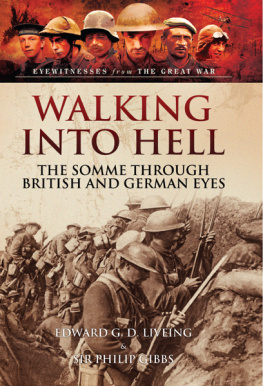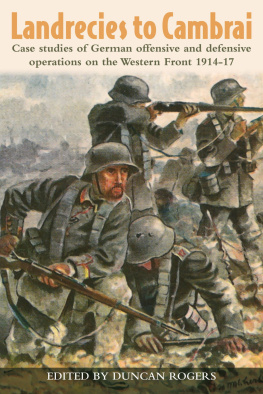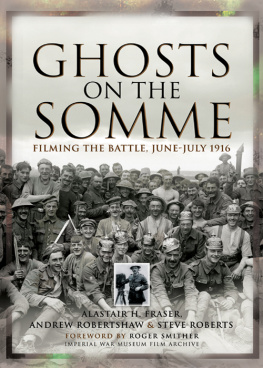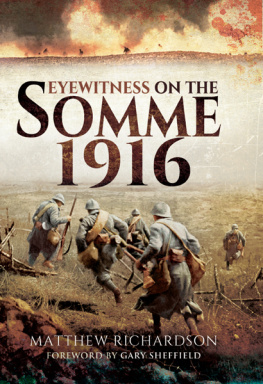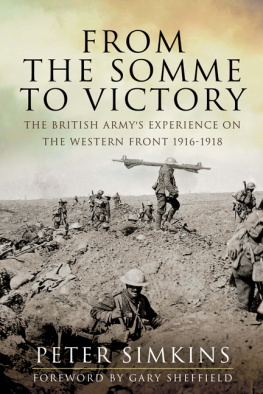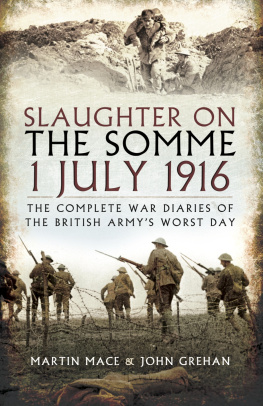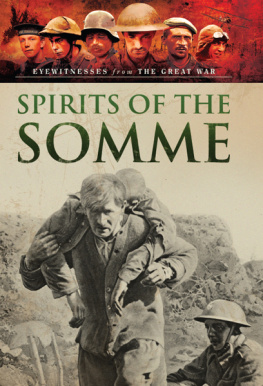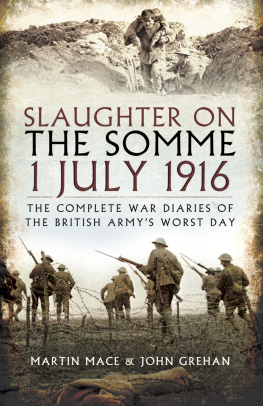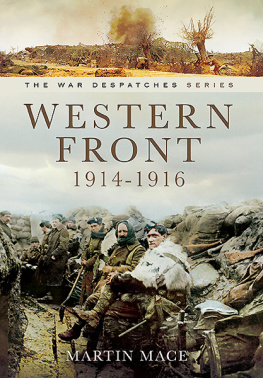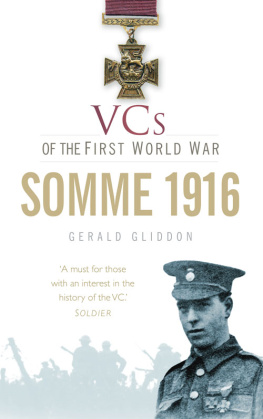This edition published in 2014 by
Pen & Sword Military
An imprint of
Pen & Sword Books Ltd
47 Church Street
Barnsley
South Yorkshire
S70 2AS
Part one of this book was first published as Attack: An Infantry Subalterns Impressions of July 1st 1916
by The Macmillan Company, New York, 1918.
Part two of this book was first published as The Germans On the Somme
by Darling & Son Ltd., London, 1917.
Copyright Coda Books Ltd.
Published under licence by Pen & Sword Books Ltd.
ISBN: 9781783463145
EPUB ISBN: 9781473850156
PRC ISBN: 9781473850330
A CIP catalogue record for this book is available from the British Library.
All rights reserved. No part of this book may be reproduced or transmitted in any form or by any means,
electronic or mechanical including photocopying, recording or by any information storage and retrieval
system, without permission from the Publisher in writing.
Printed and bound in England
By CPI Group (UK) Ltd, Croydon, CR0 4YY
Pen & Sword Books Ltd incorporates the imprints of Pen & Sword Aviation, Pen & Sword Family
History, Pen & Sword Maritime, Pen & Sword Military, Pen & Sword Discovery, Pen & Sword Politics,
Pen & Sword Atlas, Pen & Sword Archaeology, Wharncliffe Local History, Wharncliffe True Crime,
Wharncliffe Transport, Pen & Sword Select, Pen & Sword Military Classics, Leo Cooper, The Praetorian
Press, Claymore Press, Remember When, Seaforth Publishing and Frontline Publishing
For a complete list of Pen & Sword titles please contact
PEN & SWORD BOOKS LIMITED
47 Church Street, Barnsley, South Yorkshire, S70 2AS, England
E-mail:
Website: www.pen-and-sword.co.uk
CONTENTS
by Bob Carruthers
by John Masefield
by Bob Carruthers
FOREWORD
T HIS SHORT VOLUME forms part of an occasional series entitled Military History from Contemporary Sources. The idea behind the series is to provide the modern reader with a flavour of how these actions were presented to general audiences at the time the events unfolded. Im pleased to say that the series has been very well received and titles released to date seem to have pleased their readers. This series allows us the opportunity to publish accounts which are too short to form a complete volume but which nonetheless deserve to be more widely read.
This title features a short description of the action on the first day of the Somme by as viewed from the British perspective by Edward G. D. Liveing and a wonderful collection of official war dispatches by Sir Philip Gibbs which were originally published in the Daily Telegraph and Daily Chronicle.
I find this collection of especial interest as it deals with the both the British experience and also that of the all too often overlooked German Army on the Somme. The events from the British perspective are well represented in the huge volume of reports and autobiographical accounts and, like me, many of our older readers will have heard oral testimony from the participants. However, for English language readers it is much harder to gain an insight into the war as it was experienced from the German side. Gibbs work is welcome therefore as a rare example of a contemporary attempt to view the war from the other side of the hill.
BOB CARRUTHERS
PART I
THE BRITISH EXPERIENCE
BY
EDWARD G. D. LIVEING
TO
THE N.C.O.S
AND
MEN OF NO. 5 PLATOON
Of a Battalion of the County of London
Regiment, whom I had the good
fortune to command in France
during 1915-1916, and in
particular to the
memory of
RFN. C. N. DENNISON
My Platoon Observer, who fell in action
July 1st, 1916, in an attempt
to save my life
INTRODUCTION
T HE ATTACK ON the fortified village of Gommecourt, which Mr. Liveing describes in these pages with such power and colour, was a part of the first great allied attack on July 1, 1916, which began the Battle of the Somme. That battle, so far as it concerns our own troops, may be divided into two sectors: one, to the south of the Ancre River, a sector of advance, the other, to the north of the Ancre River, a containing sector, in which no advance was possible. Gommecourt itself, which made a slight but important salient in the enemy line in the containing sector, was the most northern point attacked in that first days fighting.
Though the Gommecourt position is not impressive to lock at, most of our soldiers are agreed that it was one of the very strongest points in the enemys fortified line on the Western Front. French and Russian officers, who have seen it since the enemy left it, have described it as terrible and as the very devil. There can be no doubt that it was all that they say.
The country in that part is high-lying chalk downland, something like the downland of Berkshire and Buckinghamshire, though generally barer of trees, and less bold in its valleys. Before the war it was cultivated, hedgeless land, under corn and sugar-beet. The chalk is usually well-covered, as in Buckinghamshire, with a fat day. As the French social tendency is all to the community, there are few lonely farms in that countryside as there would be with us. The inhabitants live in many compact villages, each with a church, a market-place, a watering-place for stock, and sometimes a chteau and park. Most of the villages are built of red brick, and the churches are of stone, not (as in the chalk countries with us) of dressed flint. Nearly all the villages are planted about with orchards; some have copses of timber trees. In general, from any distance, the villages stand out upon the downland as clumps of woodland. Nearly everywhere near the battlefield a clump of orchard, with an occasional dark fir in it, is the mark of some small village. In time of peace the Picardy farming community numbered some two or three hundred souls. Gommecourt and Hbuterne were of the larger kind of village.
A traveller coming towards Gommecourt as Mr. Liveing came to it, from the west, sees nothing of the Gommecourt position till he reaches Hbuterne. It is hidden from him by the tilt of the high-lying chalk plateau, and by the woodland and orchards round Hbuterne village. Passing through this village, which is now deserted, save for a few cats, one comes to a fringe of orchard, now deep in grass, and of exquisite beauty. From the hedge of this fringe of orchard one sees the Gommecourt position straight in front, with the Gommecourt salient curving round on slightly rising ground, so as to enclose the left flank.
At first sight the position is not remarkable. One sees, to the left, a slight rise or swelling in the chalk, covered thickly with the remains and stumps of noble trees, now mostly killed by shell-fire. This swelling, which is covered with the remains of Gommecourt Park, is the salient of the enemy position. The enemy trenches here jut out into a narrow pointing finger to enclose and defend this slight rise.
Further to the right, this rise becomes a low, gentle heave in the chalk, which stretches away to the south for some miles, becoming lower and gentler in its slope as it proceeds. The battered woodland which covers its higher end contains the few stumps and heaps of brick that were once Gommecourt village. The lower end is without trees or buildings.
This slight wooded rise and low, gentle heave in the chalk make up the position of Gommecourt. It is nothing but a gentle rise above a gentle valley. From a mile or two to the south of Gommecourt, this valley appearance becomes more marked. If one looks northward from this point the English lines seem to follow a slight rise parallel with the other. The valley between the two heaves of chalk make the No Mans Land or space between the enemy trenches and our own. The salient shuts in the end of the valley and enfilades it.
Next page
